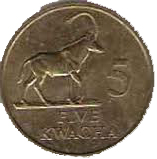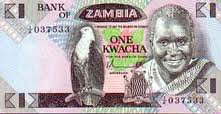|


The kwacha (ISO 4217 code: ZMK) is the currency of Zambia. It is subdivided into 100 ngwee.
Etymology
The name derives from the Nyanja and Bemba word for "dawn", alluding to the Zambian nationalist slogan of a "new dawn of freedom". The name ngwee translates as "bright" in the Nyanja language.
History
In 1968, the kwacha replaced the pound at a rate of 2 kwacha = 1 pound (10 shillings = 1 kwacha). The currency has suffered from high inflation. In 1968, the kwacha was worth 1.2 U.S. dollars, but in 2006, the dollar was worth 4,800 kwacha.
As of August 17, 2010, 1 US dollar = 4,900 kwacha.
Coins
In 1968, bronze 1 and 2 ngwee and cupro-nickel 5, 10 and 20 ngwee were introduced, followed by 50 ngwee in 1969 (click for image). In 1982, copper-clad-steel replaced bronze. The 1 and 2 ngwee were struck until 1983, with production of the 5 and 10 ngwee ceasing in 1987 and that of the 20 ngwee in 1988. Nickel-brass 1 kwacha were introduced in 1989. In 1992, a new coinage was introduced consisting of nickel-plated-steel 25 and 50 ngwee and brass 1, 5 and 10 kwacha.
All these coins remain legal tender. However, their diminished value, due to inflation and the fact that the value of the metal in the coins is worth more than the face value, means that they are never seen or used in normal trade. The only place you see coins today is when they are sold as souvenirs to tourists.
Banknotes
In 1968, the Bank of Zambia introduced notes for 50 ngwee, 1, 2, 10 and 20 kwacha. 5 kwacha notes were introduced in 1973, the same year that the last 50 ngwee notes were issued. 50 kwacha notes were introduced in 1986, with the 1 kwacha note being replaced by a coin in 1988. 100 and 500 kwacha notes were introduced in 1991, followed by 1000, 5000 and 10,000 kwacha in 1992, when the 5 and 10 kwacha notes were replaced by coins and the 2 kwacha discontinued. In 2003, 20,000 and 50,000 kwacha notes were introduced.
Until 1991, all Zambian banknotes featured a portrait of President Kenneth Kaunda on the obverse. Since 1992, all notes have instead featured a fish eagle on the obverse. Since 1989, all the reverses have featured the Chainbreaker statue. In 2003, Zambia became the first African country to issue polymer banknotes. The 500 and 1000 kwacha are both printed on polymer.
Although the 20 kwacha note is still in circulation, such is the rarity of this note that most major retailers will round prices up to the nearest 50 kwacha when calculating a total. Most items in major supermarkets are displayed using 20 kwacha in the value (e.g., 1980 kwacha).
The text on this page has been made available under the Creative Commons Attribution-ShareAlike License and Creative Commons Licenses
| 